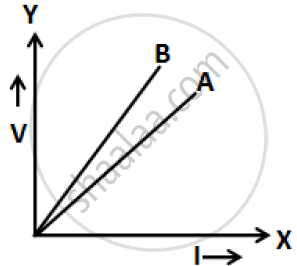Advertisements
Advertisements
प्रश्न
Two resistors having 2Ω and 3Ω resistance are connected—(i) in series, and (ii) in parallel. Find the equivalent resistance in each case.
उत्तर
Given: R1 = 2 Ω, R2 = 3 Ω
(i) In series : Equivalent resistance R = R1 + R2
or R = 2 + 3 = 5 Ω
(ii) In parallel : Equivalent resistance R = `("R"_1"R"_2)/("R"_1 + "R"_2)`
or R = `(2 xx 3)/(2 + 3) = 6/5 = 1.2 Omega`
APPEARS IN
संबंधित प्रश्न
Find the expression for resistors connected in series.
The V-I graph for a series combination and for a parallel combination of two resistors is shown in the figure below. Which of the two A or B. represents the parallel combination? Give reasons for your answer.

A p.d. of 4 V is applied to two resistors of 6 Ω and 2 Ω connected in series. Calculate:
(a) the combined resistance
(b) the current flowing
(c) the p.d. across the 6 Ω resistor
Choose the correct alternative and rewrite the following:
You are given three equal resistances. In how many combinations can they are arranged?
State expression for Cells connected in parallel.
State and explain the laws of resistance.
Three resistors of 6Ω, 3Ω and 2Ω are connected together so that their total resistance is greater than 6Ω but less than 8Ω Draw a diagram to show this arrangement and calculate its total resistance.
Two electric bulbs have resistances in the ratio 1 : 2. If they are joined in series, the energy consumed in them is in the ratio:
